Related Research Articles

The Commonwealth was the political structure during the period from 1649 to 1660 when England and Wales, later along with Ireland and Scotland, were governed as a republic after the end of the Second English Civil War and the trial and execution of Charles I. The republic's existence was declared through "An Act declaring England to be a Commonwealth", adopted by the Rump Parliament on 19 May 1649. Power in the early Commonwealth was vested primarily in the Parliament and a Council of State. During the period, fighting continued, particularly in Ireland and Scotland, between the parliamentary forces and those opposed to them, in the Cromwellian conquest of Ireland and the Anglo-Scottish war of 1650–1652.
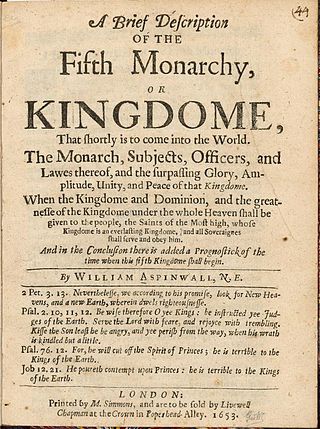
The Fifth Monarchists, or Fifth Monarchy Men, were a Protestant sect which advocated Millennialist views, active during the 1649 to 1660 Commonwealth of England. Named after a prophecy in the Book of Daniel that Four Monarchies would precede the Fifth or establishment of the Kingdom of God on earth, the group was one of a number of Nonconformist sects that emerged during the Wars of the Three Kingdoms. Perhaps its best known adherent was Major-General Thomas Harrison, executed in October 1660 as a regicide, while Oliver Cromwell was a sympathiser until 1653.

Oliver Cromwell was an English statesman, politician, and soldier, widely regarded as one of the most important figures in the history of the British Isles. He came to prominence during the 1639 to 1653 Wars of the Three Kingdoms, initially as a senior commander in the Parliamentarian army and latterly as a politician. A leading advocate of the execution of Charles I in January 1649, which led to the establishment of The Protectorate, he ruled as Lord Protector from December 1653 until his death in September 1658. Cromwell remains a controversial figure due to his use of the army to acquire political power, and the brutality of his 1649 campaign in Ireland.
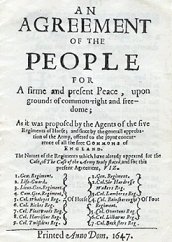
The Levellers were a political movement active during the Wars of the Three Kingdoms who were committed to popular sovereignty, extended suffrage, equality before the law and religious tolerance. The hallmark of Leveller thought was its populism, as shown by its emphasis on equal natural rights, and their practice of reaching the public through pamphlets, petitions and vocal appeals to the crowd.
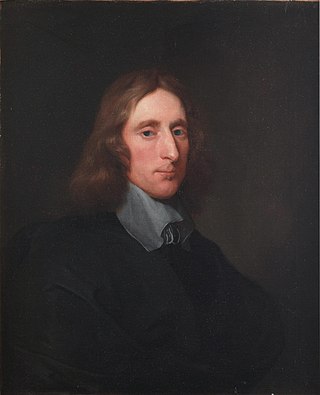
Richard Cromwell was an English statesman, the second and final Lord Protector of the Commonwealth of England, Scotland and Ireland and the son of the first Lord Protector, Oliver Cromwell.

The Protectorate, officially the Commonwealth of England, Scotland and Ireland, was the English form of government lasting from 16 December 1653 to 25 May 1659, under which the kingdoms of England, Scotland, and Ireland, with their associated territories were joined together in the Commonwealth of England, governed by a Lord Protector. It began when Barebone's Parliament was dissolved, and the Instrument of Government appointed Oliver Cromwell as Lord Protector of the Commonwealth. Cromwell died in September 1658 and was succeeded by his son Richard Cromwell.

The Rump Parliament was the English Parliament after Colonel Thomas Pride commanded soldiers to purge the Long Parliament, on 6 December 1648, of those members hostile to the Grandees' intention to try King Charles I for high treason.

Barebone's Parliament, also known as the Little Parliament, the Nominated Assembly and the Parliament of Saints, came into being on 4 July 1653, and was the last attempt of the English Commonwealth to find a stable political form before the installation of Oliver Cromwell as Lord Protector. It was an assembly entirely nominated by Oliver Cromwell and the Army's Council of Officers. It acquired its name from the nominee for the City of London, Praise-God Barebone. The Speaker of the House was Francis Rous. The total number of nominees was 140, 129 from England, five from Scotland and six from Ireland.

Colonel Edward Sexby was an English Puritan soldier and Leveller in the army of Oliver Cromwell. Later he turned against Cromwell and plotted his assassination, which Sexby considered tyrannicide, as a decapitation strike, which would then be followed by a joint regime change uprising by both Cavaliers and Levellers. Failing in his efforts, Sexby was taken prisoner and died in the Tower of London.

The Wars of the Three Kingdoms, sometimes known as the British Civil Wars, were a series of intertwined conflicts fought between 1639 and 1653 in the kingdoms of England, Scotland and Ireland, then separate entities united in a personal union under Charles I. They include the 1639 to 1640 Bishops' Wars, the First and Second English Civil Wars, the Irish Confederate Wars, the Cromwellian conquest of Ireland and the Anglo-Scottish War of 1650–1652. They resulted in victory for the Parliamentarian army, the execution of Charles I, the abolition of monarchy, and founding of the Commonwealth of England, a unitary state which controlled the British Isles until the Stuart Restoration in 1660.

Colonel John Hewson, also spelt Hughson, was a shoemaker from London and religious Independent who fought for Parliament and the Commonwealth in the Wars of the Three Kingdoms, reaching the rank of colonel. Considered one of Oliver Cromwell's most reliable supporters within the New Model Army, his unit played a prominent part in Pride's Purge of December 1648. Hewson signed the death warrant for the Execution of Charles I in January 1649, for which he reportedly sourced the headsman, while soldiers from his regiment provided security.

The English Council of State, later also known as the Protector's Privy Council, was first appointed by the Rump Parliament on 14 February 1649 after the execution of King Charles I.

The Third Protectorate Parliament sat for one session, from 27 January 1659 until 22 April 1659, with Chaloner Chute and Thomas Bampfylde as the Speakers of the House of Commons. It was a bicameral Parliament, with an Upper House having a power of veto over the Commons.
The Army Council was a body established in 1647 to represent the views of all levels of the New Model Army. It originally consisted of senior commanders, like Sir Thomas Fairfax, and representatives elected by their regiments, known as Agitators.

An Agreement of the People was a series of manifestos, published between 1647 and 1649, for constitutional changes to the English state. Several versions of the Agreement were published, each adapted to address not only broad concerns but also specific issues during the fast changing revolutionary political environment of those years. The Agreements of the People have been most associated as the manifestos of the Levellers but were also published by the Agitators and the General Council of the New Model Army.
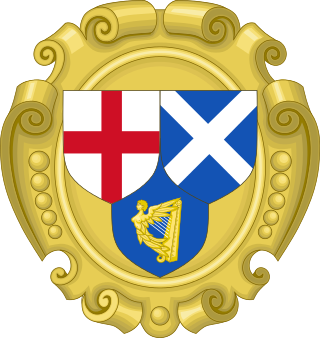
The Instrument of Government was a constitution of the Commonwealth of England, Scotland and Ireland. Drafted by Major-General John Lambert in 1653, it was the first sovereign codified and written constitution in England.
The Rule of the Major-Generals, was a period of direct military government from August 1655 to January 1657, during Oliver Cromwell's Protectorate. England and Wales were divided into ten regions, each governed by a major-general who answered to the Lord Protector.
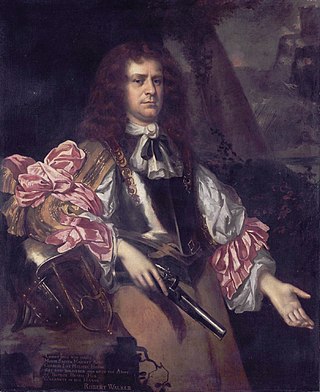
Lieutenant-Colonel George Joyce was an officer and Agitator in the Parliamentary New Model Army during the English Civil War.

Colonel Nathaniel Rich was a member of the landed gentry from Essex, who sided with Parliament during the Wars of the Three Kingdoms. He has been described as "an example of those pious Puritan gentlemen who were inspired by the ideals of the English Revolution".

The interregnum in the British Isles began with the execution of Charles I in January 1649 and ended in May 1660 when his son Charles II was restored to the thrones of the three realms, although he had been already acclaimed king in Scotland since 1649. During this time the monarchial system of government was replaced with the Commonwealth of England.
References
- Durston, Chris (1985), "Lords of Misrule: The Puritan War on Christmas 1642–60", History Today, vol. 35, History Today Ltd